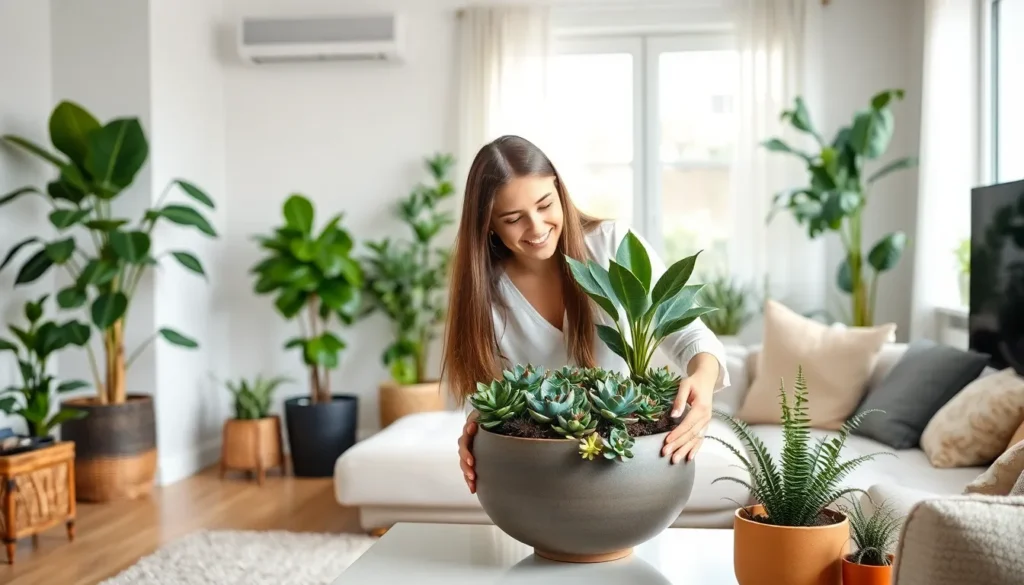We’ve all walked into a room and felt instantly drawn to its warmth and vitality – chances are plants played a starring role in that magic. Interior design with plants isn’t just about adding greenery; it’s about creating living spaces that breathe life into our homes and boost our well-being.
Plants transform any interior from sterile to spectacular while offering incredible health benefits like improved air quality and reduced stress levels. Whether you’re working with a tiny apartment or a sprawling home we’ll show you how to seamlessly blend nature with your design aesthetic.
From selecting the perfect plants for different lighting conditions to styling them like a pro we’re diving deep into the art of botanical interior design. Get ready to discover how the right plants can elevate your space and create the sanctuary you’ve always dreamed of.
Choose the Right Plants for Your Interior Design Style
Selecting plants that harmonize with your existing decor creates a cohesive and intentional look throughout your home. We’ll explore how different plant varieties can enhance exact design aesthetics while maintaining the natural beauty that makes botanical elements so appealing.
Match Plants to Modern Minimalist Aesthetics
Architectural plants with clean lines work best in minimalist spaces where simplicity reigns supreme. Snake plants (Sansevieria trifasciata) offer striking vertical elements with their sword-like leaves and require minimal maintenance. Fiddle leaf figs provide sculptural presence without overwhelming clean surfaces.
Monochromatic green palettes complement neutral color schemes commonly found in modern interiors. ZZ plants (Zamioculcas zamiifolia) feature glossy leaves that reflect light beautifully against white walls. Peace lilies add elegant white blooms that align with minimalist color preferences.
Geometric planters in materials like concrete, ceramic, or metal enhance the contemporary aesthetic. We recommend choosing containers with simple shapes that don’t compete with your plant’s natural form. Cylindrical or rectangular vessels work particularly well with architectural plant varieties.
Complement Traditional and Classic Decor
Refined foliage plants suit the elegance of traditional interiors with their timeless appeal. Boston ferns bring Victorian charm with their cascading fronds and work beautifully in hanging baskets. English ivy creates sophisticated trailing elements when displayed in classic urns or pedestals.
Rich textures enhance the layered complexity typical of traditional design styles. Rubber trees (Ficus elastica) provide substantial presence with their broad, glossy leaves. Philodendrons offer heart-shaped foliage that adds romantic touches to formal living spaces.
Ornate containers in brass, ceramic, or wicker complement traditional furnishings and architectural details. We suggest selecting planters with decorative elements like embossed patterns or classical motifs. Antique-style cachepots work particularly well for displaying smaller plants like African violets or begonias.
Enhance Bohemian and Eclectic Spaces
Trailing varieties create the lush, layered look that defines bohemian style perfectly. Pothos plants cascade beautifully from macrame hangers or high shelves. String of hearts (Ceropegia woodii) adds delicate trailing elements with unique heart-shaped leaves and purple stems.
Textural diversity supports the eclectic mix of patterns and materials common in boho spaces. Monstera deliciosa provides dramatic split leaves that serve as natural art pieces. Pilea peperomioides offers coin-shaped leaves that create interesting contrast against flowing fabrics and tapestries.
Unconventional displays using vintage vessels, woven baskets, or repurposed containers align with bohemian creativity. We encourage mixing different pot sizes and heights to create ever-changing groupings. Hanging plants at various levels adds vertical interest and enhances the free-spirited atmosphere that makes eclectic spaces so inviting.
Create Stunning Plant Arrangements by Room
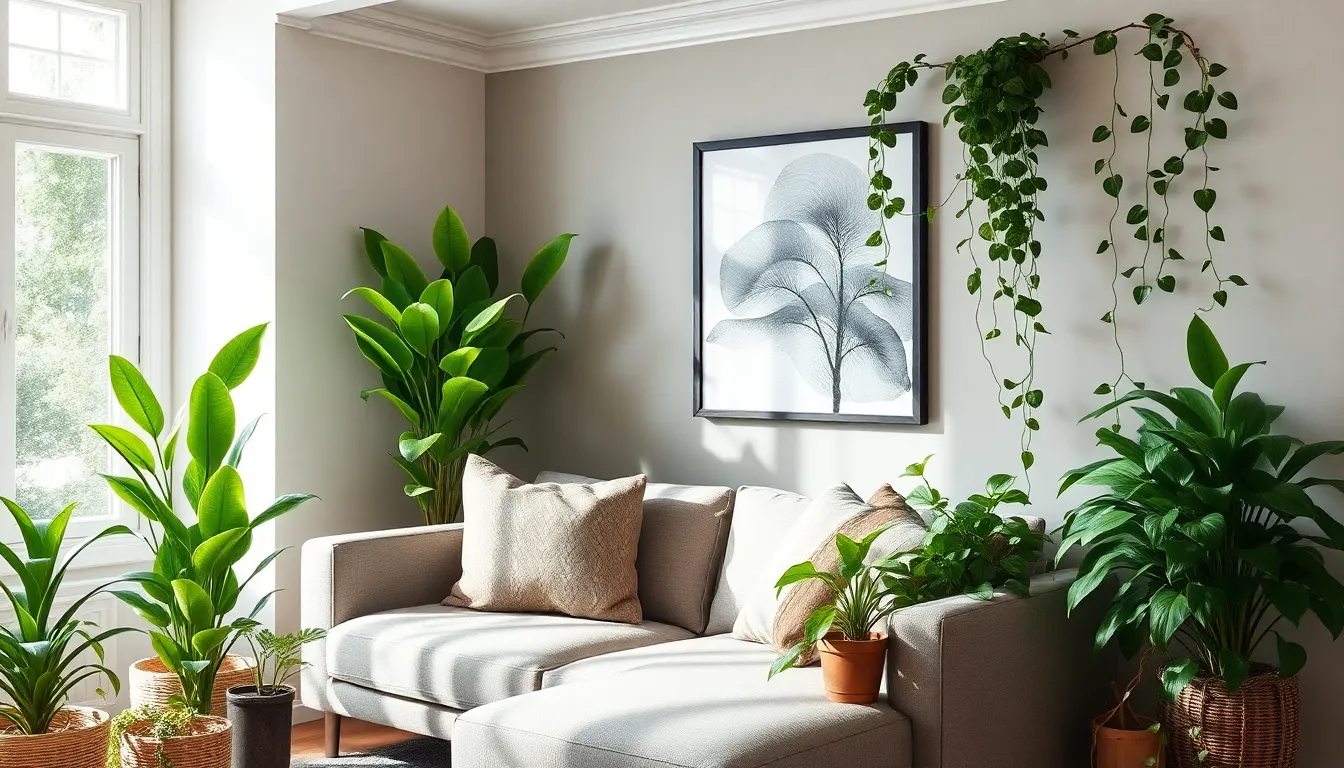
Thoughtful plant placement transforms each space into a cohesive, living environment that reflects your personal style. We’ll show you how to curate botanical arrangements that enhance every room’s unique function and atmosphere.
Transform Your Living Room with Statement Plants
Position tall plants such as snake plants, rubber plants, corn plants (Dracaena), fiddle leaf figs, or majesty palms strategically to add height and draw eyes upward. This vertical emphasis makes spaces feel larger and creates better visual balance throughout your living area.
Combine climbing vines like Devil’s Ivy around pendant lights or furniture pieces to establish memorable focal points. These trailing plants add organic movement and soften hard architectural lines.
Use a mix of plant sizes and shapes to create balanced clusters that command attention. Combining tall, slim, and stubby plants creates visual interest while maintaining harmony with your room’s existing lighting conditions.
Select plants that complement your living room’s style and natural light patterns. This ensures your green additions enhance rather than compete with your carefully chosen décor elements.
Design a Green Kitchen with Herb Gardens
Vertical herb gardens or wall mounted planters maximize your kitchen’s limited counter space while providing fresh ingredients for daily cooking. These compact growing systems transform empty walls into productive green features.
Choose herbs that thrive in your kitchen’s exact light and temperature conditions. Basil, thyme, and mint flourish in most kitchen environments and tolerate the humidity from cooking activities.
Arrange plants to avoid cluttering essential work surfaces while keeping herbs within easy reach. Strategic placement near windows or above sinks creates both functional and aesthetic appeal.
Use decorative containers that complement your kitchen’s color scheme and style. Matching planters create visual cohesion while individual pots allow flexibility in arrangement.
Build a Relaxing Bedroom Plant Sanctuary
Choose low maintenance plants that purify air and thrive in indirect light conditions. Snake plants, pothos, ZZ plants, and Chinese money plants require minimal care while improving your sleep environment.
Place hanging plants or small potted varieties on bedside tables and shelves to add natural elements without creating surface clutter. These elevated positions keep plants safe while maximizing visual impact.
Select air purifying varieties known to enhance relaxation and sleep quality. These plants work quietly overnight to remove toxins and increase oxygen levels in your bedroom sanctuary.
Position plants away from direct airflow from heating and cooling vents. This protects your plants while ensuring they contribute to a peaceful, undisturbed sleep environment.
Establish a Productive Home Office with Air-Purifying Plants
Incorporate easy care plants that actively purify air and boost focus throughout your workday. Spider plants, peace lilies, and snake plants remove common indoor pollutants while requiring minimal attention.
Use taller plants to add vertical interest and break up monotonous desk arrangements. These statement pieces improve your workspace’s aesthetics while creating natural visual breaks.
Arrange plants strategically to avoid obstructing essential work areas while maintaining clear surfaces for productivity. Consider desk sized plants or wall mounted options for compact home offices.
Match plant selections to your office’s lighting and temperature conditions. Low light tolerant varieties like ZZ plants suit dim corners, while bright spaces accommodate a wider range of options.
Master the Art of Plant Placement and Scale
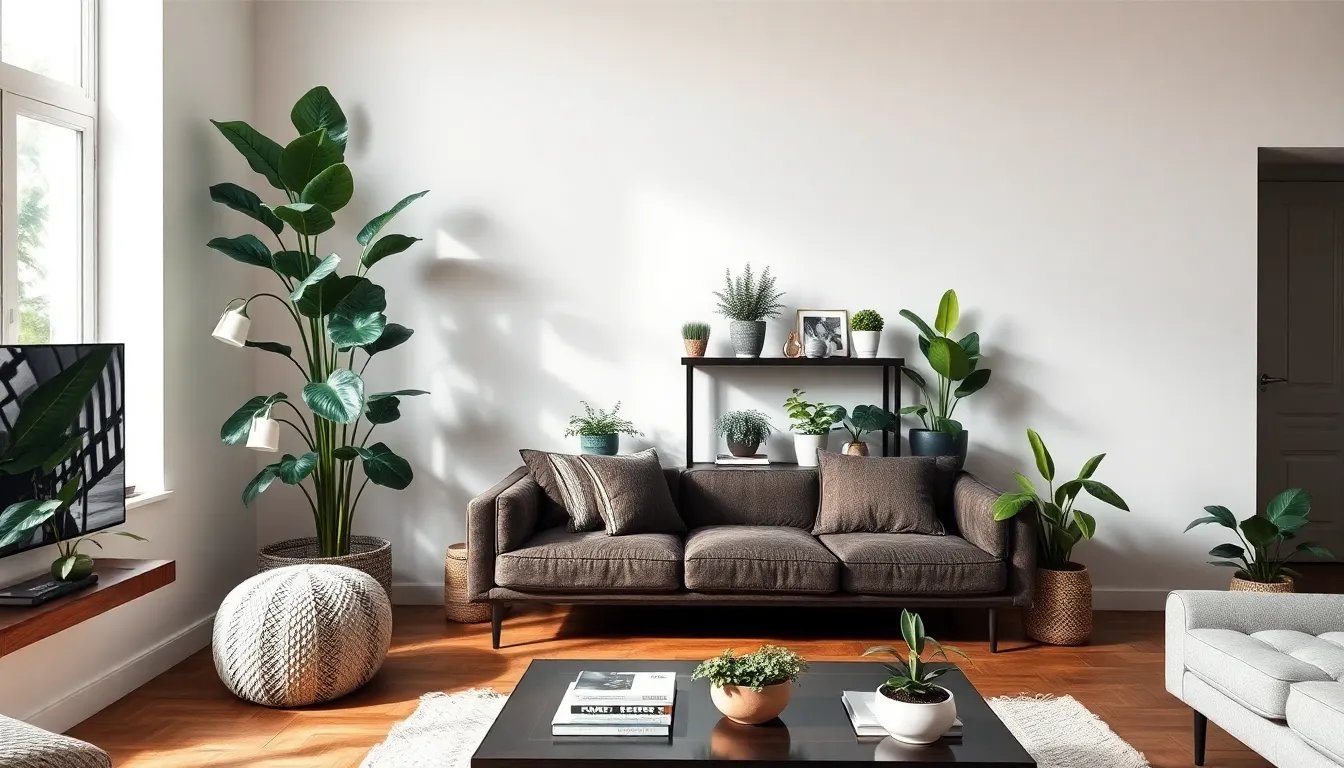
Strategic plant placement transforms ordinary spaces into vibrant, well-balanced environments. We’ll show you how different plant sizes create depth and visual harmony throughout your home.
Use Large Floor Plants as Natural Room Dividers
Tall plants like fiddle leaf figs and monstera deliciosa excel at filling empty corners or awkward spaces near sofas and windows. These architectural beauties serve as natural dividers that subtly separate areas without requiring heavy furniture pieces.
Position these statement plants with approximately 3 feet of clearance around them. This spacing ensures proper airflow while preventing them from crowding your existing furniture. Large floor plants become visual anchors that ground your room’s design when placed thoughtfully.
Corner placement works particularly well for creating dramatic focal points. We recommend positioning tall plants in spots where they can catch natural light while maintaining that essential breathing room for both aesthetic appeal and plant health.
Position Medium Plants on Tables and Shelves
Medium-sized plants thrive on surfaces like bookshelves, fireplace mantels, and side tables. Creating layered visual interest becomes effortless when you place these plants at varying heights using benches or decorative stools.
Group medium plants in odd numbers, particularly sets of three, for natural-looking arrangements. This clustering technique mimics how plants grow in nature while creating balanced compositions that feel organic rather than forced.
Ensure your chosen spots provide suitable lighting and humidity conditions for each plant species. We’ve found that matching plant needs to exact locations prevents both design disasters and plant casualties down the road.
Incorporate Small Plants for Accent Details
Small plants or “greenies” add delicate accents on coffee tables, window sills, and in hanging pots without overwhelming your space. These miniature botanical elements provide finishing touches that complete your plant design story.
Use small plants sparingly to maintain aesthetic clarity. We recommend limiting yourself to one plant per small bench or tabletop to avoid visual clutter that can make spaces feel cramped.
Hanging installations work beautifully for small plants when ceiling height allows. Suspended planters create vertical interest while keeping surfaces clear for daily use, making them perfect for compact living areas.
Select the Perfect Planters and Containers
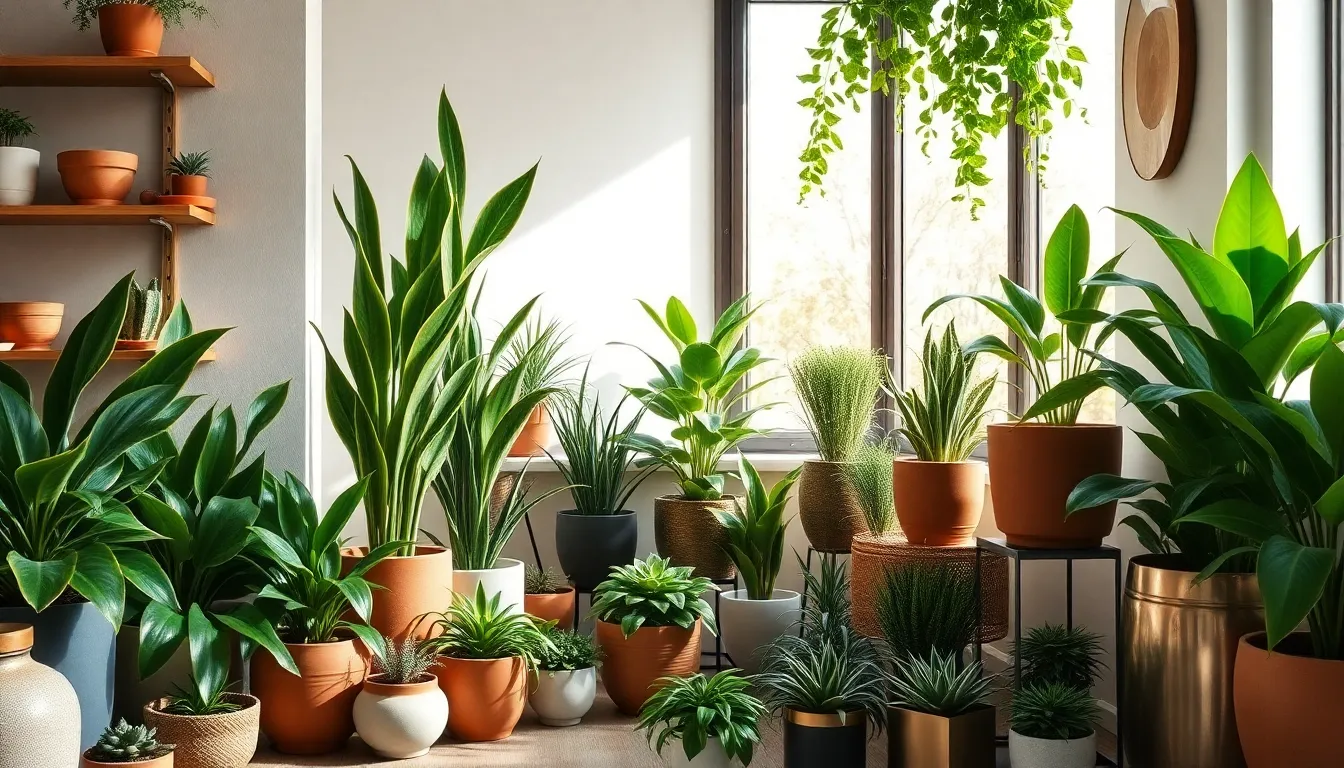
Now that we’ve explored strategic placement and scale, let’s jump into choosing the right containers to showcase our plants beautifully. Selecting planters that complement our interior design creates cohesive spaces where greenery truly shines.
Choose Materials That Match Your Design Theme
Materials for planters should harmonize with our existing décor to create visual unity throughout our homes. Ceramic pots work beautifully in contemporary spaces, offering clean lines and smooth finishes that complement modern furniture. Terracotta brings warmth to traditional interiors while providing excellent drainage for plant health.
Metal planters add industrial flair to modern spaces, especially when paired with sleek geometric shapes that echo architectural elements. Wood containers enhance rustic or Scandinavian aesthetics, bringing natural textures that connect with wooden furniture and flooring. Woven natural fibers like rattan create perfect accents for bohemian interiors, adding organic textures that complement eclectic furnishings.
Matching planter textures and finishes to our furniture and accessories ensures cohesion across rooms. We should consider how metallic finishes on planters can echo hardware details on cabinets or lighting fixtures.
Consider Size and Proportion for Visual Balance
Visual balance becomes crucial when styling plants in containers of varying sizes. Combining tall, narrow plants like snake plants or rubber plants creates height and draws the eye upward, making rooms feel larger and more airy. We can achieve stunning displays by clustering various sizes and shapes from tall trees to stubby succulents.
Placing one taller plant next to shorter ones on shelves creates pleasing asymmetrical arrangements that avoid monotony. We should avoid overcrowding by selecting planters that fit well within our room’s scale rather than overwhelming the space. Large floor planters work best in spacious areas, while compact containers suit intimate settings like side tables or window sills.
Proportionality matters when grouping multiple plants together. We recommend using the rule of thirds, where different sized planters create ever-changing triangular compositions that feel naturally balanced.
Explore Creative and Unique Planter Options
Interior landscaping with plants offers endless creative possibilities beyond traditional pots. Hanging baskets or kokedama suspended from ceilings create floating effects that add vertical interest without consuming floor space. These elevated displays work particularly well in compact living areas where surface space is limited.
Wall mounted planters transform blank walls into living art installations. Vertical gardens serve dual purposes as room dividers and statement décor, defining areas without blocking natural light flow. We can wrap vines around furniture or light fixtures for organic, statement décor that integrates plants seamlessly into our existing furnishings.
Simple pots arranged on shelves create “green pops” that brighten rooms with minimal effort. Geometric mounts allow plants to double as wall art, making greenery both space efficient and visually striking. Combining vines with features like pendant lights creates memorable focal points that anchor entire room designs.
Design Vertical Gardens and Living Walls
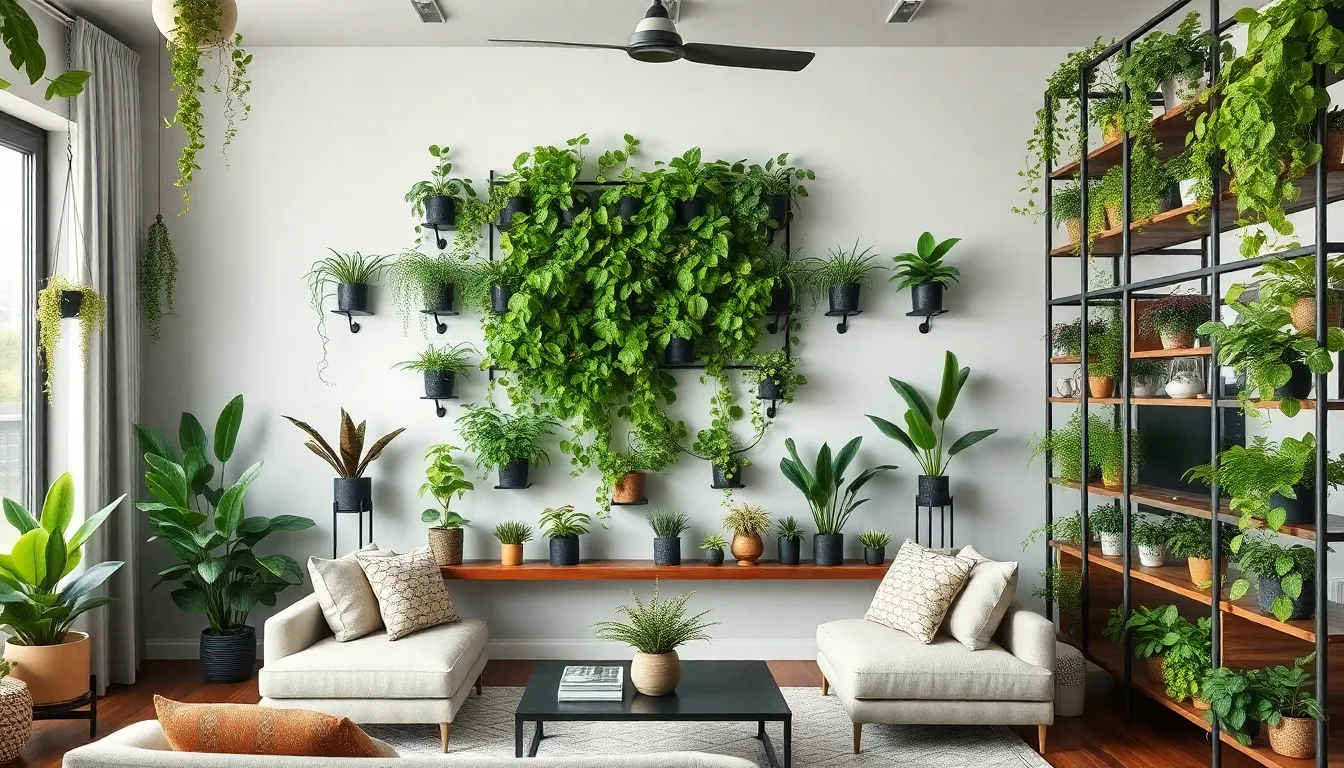
Vertical gardens transform walls into living masterpieces that maximize greenery in minimal floor space. Living walls serve as natural air filters while creating stunning focal points that enhance our connection with nature indoors.
Install Wall-Mounted Planters for Small Spaces
Wall-mounted planters optimize compact interiors by utilizing vertical surfaces that would otherwise remain bare. We can create ever-changing displays using modular systems that allow plants to grow hydroponically without occupying precious floor area.
Strategic placement maximizes both visual impact and plant health. Mount planters at eye level for easy maintenance while ensuring adequate lighting reaches each plant. Position multiple planters in staggered arrangements to create depth and visual interest along hallways or accent walls.
Material selection influences both durability and aesthetic appeal. Choose moisture-resistant materials like powder-coated metal or sealed wood to prevent water damage. Consider planters with built-in drainage systems or water collection trays to protect wall surfaces from moisture.
Create Hanging Plant Displays from Ceilings
Hanging installations draw our eyes upward while adding layers of greenery that enrich indoor environments. Ceiling-mounted plants create ever-changing displays that bring nature overhead without compromising floor or surface space.
Weight distribution ensures safe installations that protect both plants and occupants. Calculate the combined weight of plants, soil, and containers before selecting appropriate ceiling anchors. Use ceiling joists or structural supports for heavier installations to prevent accidents.
Height variations create visual rhythm throughout the space. Suspend plants at different levels using adjustable cables or chains to establish natural movement patterns. Group trailing varieties like pothos with upright plants to achieve balanced compositions that enhance biophilic design principles.
Build Custom Shelving Systems for Plant Collections
Custom shelving maximizes plant display potential while incorporating fractal patterns that naturally reduce stress levels. We design tiered systems that accommodate various plant sizes while creating organized collections that serve as living art installations.
Modular construction allows flexibility as plant collections grow and change seasonally. Build adjustable shelves using brackets that can be repositioned to accommodate plants of different heights. Incorporate grow lights into upper shelves to support plants in darker corners of rooms.
Material considerations balance functionality with aesthetic appeal in plant-focused environments. Select moisture-resistant woods like cedar or teak that withstand humidity from watering routines. Add protective finishes or glass shelves in high-moisture areas to prevent warping and extend shelf life.
Space optimization transforms unused areas into productive plant habitats. Design corner units that use awkward spaces while creating impressive vertical displays. Include integrated water collection systems or removable trays to simplify maintenance and protect surrounding surfaces.
Understand Lighting Requirements for Indoor Plants
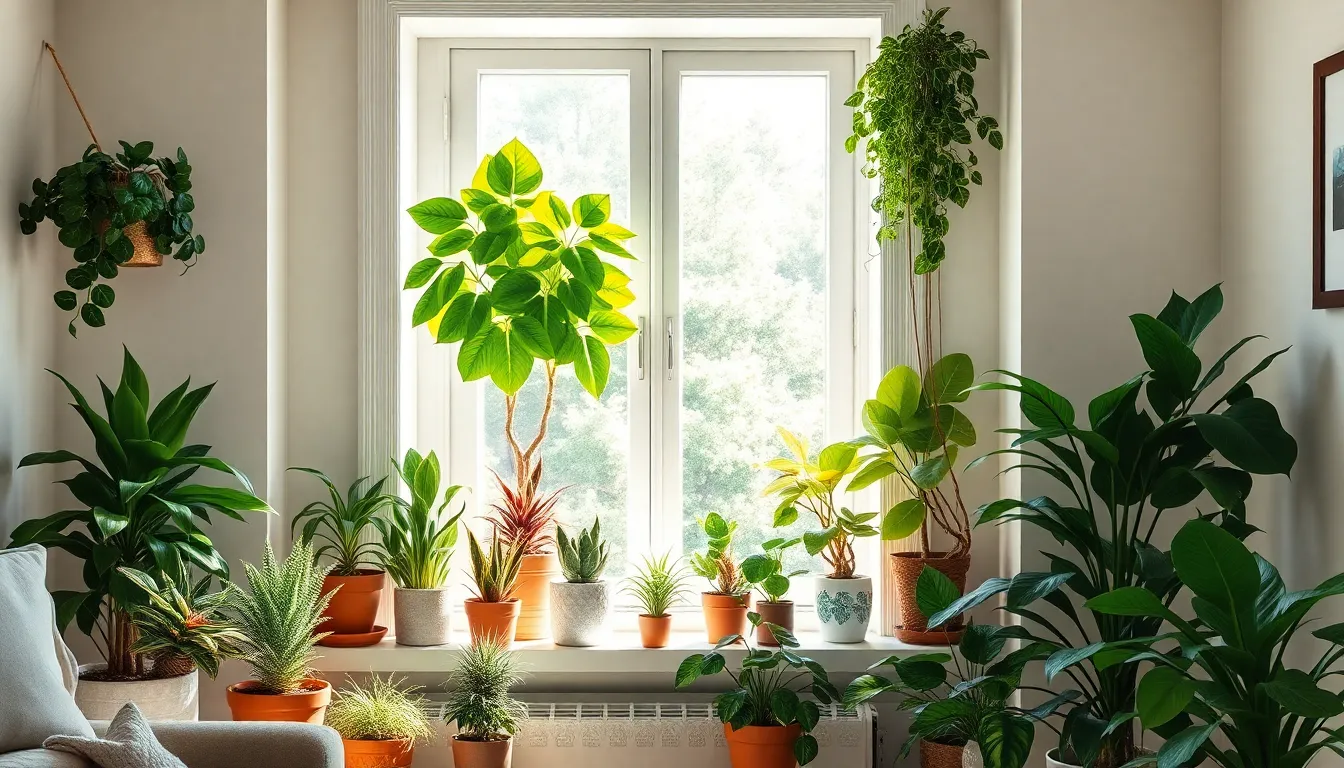
Successful plant integration requires understanding each species’ exact light needs. We’ll categorize plants into three main lighting groups to help you make informed placement decisions.
High light plants demand bright locations like south or southwest facing windows where direct sunlight streams in for several hours daily. These plants typically include succulents, cacti, and flowering varieties that originated in sunny climates. Direct sunlight creates warmer conditions that cause soil to dry faster, requiring more frequent watering schedules.
Medium light plants flourish near east facing or west facing windows but away from harsh direct rays. Popular choices like pothos, rubber trees, and prayer plants fall into this category. Artificial lighting becomes necessary when starting seeds or promoting active growth phases during darker months.
Low light plants adapt beautifully to north facing windows or shaded interior corners with minimal direct sunlight exposure. Snake plants, ZZ plants, and peace lilies grow slower in these conditions and consume less water, making overwatering our primary concern.
Maximize Natural Light Sources
Assessment of your space’s natural light quality forms the foundation for strategic plant placement. We observe window directions throughout the day and identify obstructions like heavy curtains, nearby trees, or neighboring buildings that block precious sunlight.
Direct sunlight loving species belong on windowsills or spots receiving unobstructed light for 6-8 hours daily. South facing windows provide the most intense light, perfect for sun hungry plants like jade plants and aloe vera.
Sheer curtains or strategically placed furniture help us diffuse harsh afternoon light for plants preferring bright indirect conditions. East facing windows offer gentle morning sun followed by bright indirect light, ideal for many tropical houseplants.
Grouping plants according to light requirements creates efficient zones throughout our living spaces. We position sun lovers near bright windows while shade tolerant varieties thrive in dimmer corners, maximizing natural illumination effectiveness across different areas.
Supplement with Artificial Grow Lights
Grow lights become essential when natural sunlight proves insufficient or inconsistent throughout seasonal changes. These artificial sources mimic sunlight’s spectrum, ensuring our plants receive adequate energy for photosynthesis and healthy development.
LED grow lights offer superior energy efficiency while producing minimal heat compared to traditional options. Full spectrum LEDs closely resemble natural daylight, providing the complete light spectrum plants need for optimal growth and vibrant foliage.
Cool white or full spectrum bulbs deliver the exact wavelengths required for photosynthesis and overall plant health indoors. We choose fixtures that can be adjusted for height as plants grow, ensuring consistent light distribution.
Installation locations should target areas where natural sunlight doesn’t reach adequately or during winter months with shortened daylight hours. Timer controlled systems automate lighting schedules, providing consistent daily light exposure without manual intervention.
Position Plants According to Light Needs
Strategic positioning transforms our understanding of light requirements into practical plant placement answers. We create thriving indoor gardens by matching each plant’s needs with the appropriate location’s light conditions.
High light plants occupy prime real estate near bright windows with direct sun exposure for several hours daily. These positions typically include south facing windowsills, sunroom locations, or areas receiving unfiltered morning and afternoon light.
Medium light plants find their perfect spots where filtered or indirect light creates ideal growing conditions. East or west facing windows positioned slightly back from the glass provide excellent medium light environments.
Low light plants settle comfortably in shaded room sections, away from direct sun but still receiving ambient light. North facing windows, hallway corners, or areas several feet from bright windows suit these adaptable species perfectly.
Regular rotation ensures even light exposure on all plant sides, promoting balanced growth and preventing plants from leaning toward their light source. We turn plants one quarter rotation weekly to maintain symmetrical development and healthy foliage distribution.
Maintain Your Interior Design with Plants
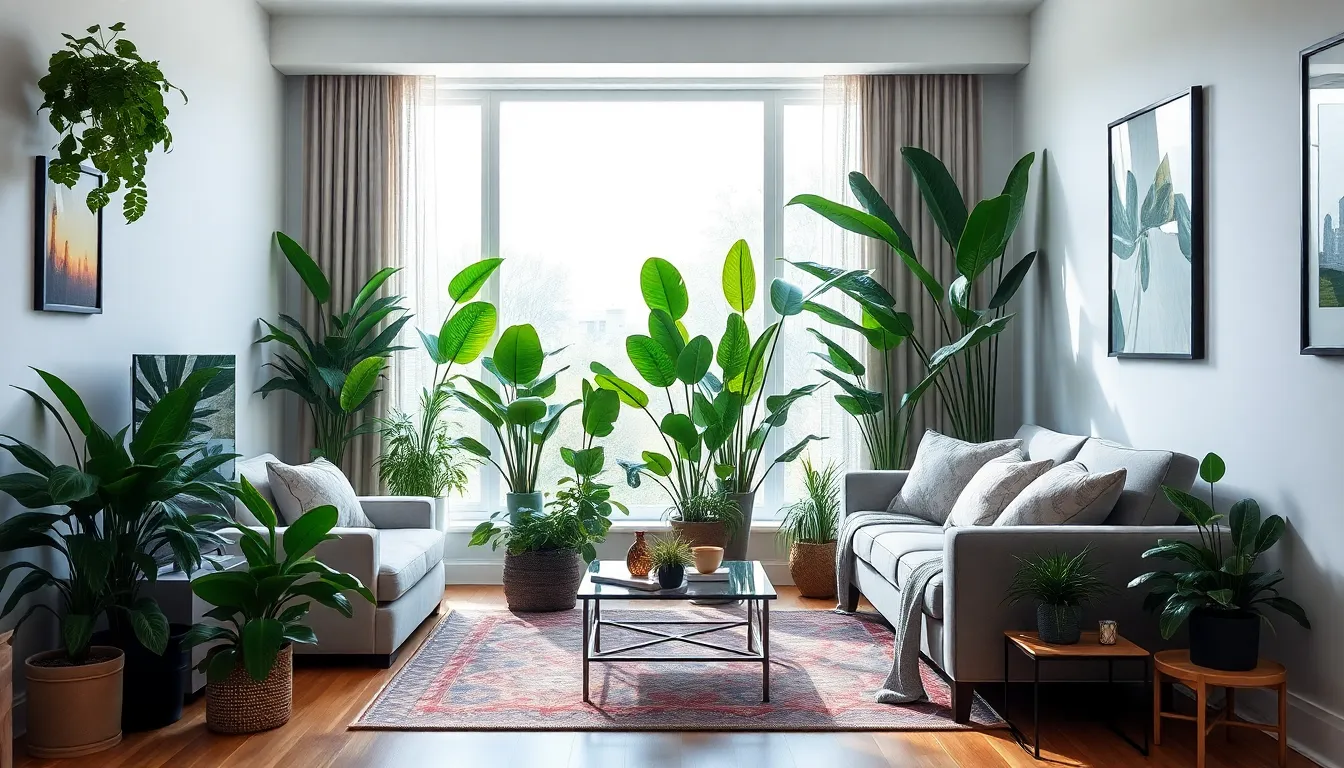
Sustaining the beauty and benefits of our plant-enhanced interiors requires consistent care practices that keep our green companions thriving. These maintenance strategies ensure our botanical elements continue to enhance our spaces while contributing to healthier, happier indoor environments.
Establish Regular Watering and Care Routines
Create consistent watering schedules that match each plant’s exact needs rather than watering all plants at once. Different species require varying amounts of water, so we develop individual care calendars for optimal plant health.
Check soil moisture levels using our finger or a moisture meter before watering to prevent both overwatering and underwatering. Most houseplants prefer soil that’s slightly moist but not waterlogged.
Establish weekly grooming sessions where we dust leaves, remove dead foliage, and inspect for any issues. Clean leaves allow plants to photosynthesize more efficiently while maintaining their aesthetic appeal in our designed spaces.
Position plants near water sources during our initial design phase to make routine care more manageable. Strategic placement reduces the effort needed for regular maintenance.
Monitor Plant Health and Growth Patterns
Observe leaf color changes as early indicators of plant stress, nutrient deficiencies, or environmental issues that could affect our interior design’s visual impact. Yellow or brown leaves often signal watering problems or insufficient light.
Watch for pest infestations like spider mites, aphids, or scale insects that can quickly spread throughout our plant collection. Early detection prevents damage to both individual plants and our overall design aesthetic.
Track growth patterns to determine when plants outgrow their containers or designated spaces in our design scheme. Rapid growth may require repotting or relocation to maintain visual balance.
Document plant responses to different locations within our homes to identify optimal placement for both plant health and design effectiveness. This information helps us make informed decisions about future arrangements.
Replace and Rotate Plants Seasonally
Rotate plant positions every few months to ensure even growth and prevent plants from leaning toward light sources. This practice maintains the symmetrical appearance essential to our design vision.
Replace struggling plants promptly to preserve the cohesive look of our botanical interior design. A single unhealthy plant can detract from the entire aesthetic we’ve carefully created.
Introduce seasonal varieties that complement changing light conditions and indoor climate throughout the year. Spring might bring flowering plants while winter calls for hardy, low-light tolerant species.
Refresh plant groupings by rearranging combinations and adding new specimens to keep our interiors feeling ever-changing and current. These updates prevent our plant displays from becoming stagnant or predictable.
Conclusion
Transforming our homes with plants isn’t just about following trends—it’s about creating spaces that nurture our well-being and reflect our personal style. We’ve explored how strategic plant placement thoughtful container selection and proper lighting can turn any room into a thriving green sanctuary.
The beauty of botanical interior design lies in its flexibility. Whether we’re working with a sprawling living room or a compact studio apartment we can always find ways to incorporate nature’s vitality into our daily lives.
Remember that successful plant-filled interiors require ongoing attention and care. By establishing consistent maintenance routines and understanding each plant’s unique needs we’ll ensure our green companions continue to enhance our homes for years to come.
Frequently Asked Questions
What are the main benefits of incorporating plants into interior design?
Plants enhance interior spaces by improving air quality, reducing stress levels, and adding natural warmth and vitality to any room. They serve as living decorative elements that bring life to your home while providing measurable health benefits. Plants also help create a more relaxing and welcoming atmosphere for both residents and guests.
How do I choose plants that match my interior design style?
For modern minimalist spaces, select architectural plants like snake plants and fiddle leaf figs with geometric planters. Traditional decor works well with refined foliage plants such as Boston ferns and rubber trees in ornate containers. Bohemian styles benefit from trailing varieties like pothos and string of hearts displayed in unconventional ways.
Which plants work best in different rooms of the house?
Living rooms benefit from tall plants like majesty palms for height and visual balance. Kitchens are perfect for vertical herb gardens that provide fresh ingredients. Bedrooms should feature low-maintenance, air-purifying plants that thrive in indirect light. Home offices work well with focus-boosting plants like snake plants or pothos.
How do I arrange plants effectively using scale and placement?
Use large floor plants like fiddle leaf figs as natural room dividers and visual anchors. Place medium-sized plants on tables and shelves in odd-numbered groups for visual interest. Small plants work as delicate accents on coffee tables and windowsills. Consider hanging installations to add vertical interest in compact spaces.
What types of planters should I choose for my plants?
Select planters that match your design theme for visual unity. Ceramic and terracotta work well for traditional styles, while metal and geometric shapes suit modern aesthetics. Wooden and woven natural fiber planters complement bohemian decor. Always ensure proper size and proportion following the rule of thirds for grouping.
How do I determine the right lighting for my indoor plants?
Categorize plants by their light requirements: high-light plants need direct sunlight, medium-light plants thrive in bright indirect light, and low-light plants tolerate dimmer conditions. Position plants strategically according to their needs, maximize natural light sources, and use artificial grow lights when necessary for optimal growth.
What maintenance practices keep plant-enhanced interiors looking their best?
Establish consistent watering routines tailored to each plant’s needs and monitor regularly for signs of stress or pests. Rotate plants periodically to promote balanced growth and maintain visual harmony. Track growth patterns to ensure continued aesthetic balance, and consider seasonal plant rotation to keep displays fresh and cohesive.
Can I create vertical gardens in small spaces?
Yes, vertical gardens and living walls are excellent solutions for compact interiors. Use wall-mounted planters to optimize space while creating living art pieces. Focus on strategic placement for both visual impact and plant health, ensuring proper weight distribution and adequate lighting for all plants in the vertical display.

